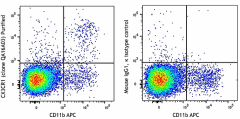- Clone
- QA16A03 (See other available formats)
- Regulatory Status
- RUO
- Other Names
- Chemokine (C-X3-C motif) receptor 1, Fractalkine receptor, GPR13, CCRL1, CMKBRL1, CMKDR1, V28
- Isotype
- Mouse IgG1, κ
- Ave. Rating
- Submit a Review
- Product Citations
- publications

-

C57BL/6 mouse splenocytes were stained with CD11b APC and Ultra-LEAF™ Purified CX3CR1 (clone QA16A03) (left) or Purified Mouse IgG1, κ (right) followed by anti-mouse IgG1 PE.
| Cat # | Size | Price | Quantity Check Availability | Save | ||
|---|---|---|---|---|---|---|
CX3CR1 is a 40 kD, G-protein coupled receptor, with seven transmembrane regions. CX3CR1 is expressed by resident and alternatively activated macrophages (M2), a subset of monocytes, dendritic cells (DCs), NK cells, a subset of memory T cells, and mast cells. CX3CR1 is involved in cell recruitment during inflammation and participates in cell adhesion and extravasation from blood vessels. Its ligand is CX3CL1, also known as fractalkine or neurotactin. CX3CR1 is also a coreceptor for HIV1 and variations in this gene leads to increased susceptibility to HIV. In the brain, it is expressed by glial cells, which interact with CX3CL1 expressed by neurons.
Product DetailsProduct Details
- Verified Reactivity
- Mouse
- Antibody Type
- Recombinant
- Host Species
- Mouse
- Immunogen
- Mouse CX3CR1-transfected cells
- Formulation
- 0.2 µm filtered in phosphate-buffered solution, pH 7.2, containing no preservative. Endotoxin level is <0.01 EU/µg of the protein (<0.001 ng/µg of the protein) as determined by the LAL test.
- Preparation
- The Ultra-LEAF™ (Low Endotoxin, Azide-Free) antibody was purified by affinity chromatography.
- Concentration
- The antibody is bottled at the concentration indicated on the vial, typically between 2 mg/mL and 3 mg/mL. Older lots may have also been bottled at 1 mg/mL. Please contact technical support for concentration and total µg amount, or use our Lookup tool if you have a lot number.
- Storage & Handling
- The antibody solution should be stored undiluted between 2°C and 8°C. This Ultra-LEAF™ solution contains no preservative; handle under aseptic conditions.
- Application
-
FC - Quality tested
- Recommended Usage
-
Each lot of this antibody is quality control tested by immunofluorescent staining with flow cytometric analysis. For flow cytometric staining, the suggested use of this reagent is ≤ 0.03 µg per million cells in 100 µl volume. It is recommended that the reagent be titrated for optimal performance for each application.
- Application Notes
-
This recombinant antibody clone is derived from clone SA011F11.
- Product Citations
-
Antigen Details
- Structure
- G-protein coupled receptor, 7 transmembrane regions, 40 kD.
- Distribution
-
Resident and alternatively activated macrophages (M2), subset of monocytes, dendritic cells (DCs), natural killer cells (NK), subset of memory T cells, mast cells, glial cells, and astrocytes.
- Function
- Involved in cell recruitment during inflammation, participates in cell adhesion and extravasation from blood vessels, coreceptor for HIV1.
- Ligand/Receptor
- CX3CL1 (fractalkine, neurotactin).
- Cell Type
- Astrocytes, Dendritic cells, Macrophages, Mast cells, Microglia, Monocytes, NK cells, T cells
- Biology Area
- Cell Biology, Immunology, Neuroinflammation, Neuroscience, Neuroscience Cell Markers
- Molecular Family
- Cytokine/Chemokine Receptors, GPCR
- Antigen References
-
- Hamon P, et al. 2017. Blood.129:1296
- Afik R, et al. 2016. J Exp Med. 213:2315
- Mass E, et al. 2016. Science. 353 pii: aaf4238
- Safaiyan S, et al. 2016. Nat Neurosci. 19:995
- Peng J, et al. 2016. Nat Commun. 7:12029
- Gene ID
- 13051 View all products for this Gene ID
- Specificity (DOES NOT SHOW ON TDS):
- CX3CR1
- Specificity Alt (DOES NOT SHOW ON TDS):
- CX3CR1
- App Abbreviation (DOES NOT SHOW ON TDS):
- FC
- UniProt
- View information about CX3CR1 on UniProt.org
Related FAQs
- Do you guarantee that your antibodies are totally pathogen free?
-
BioLegend does not test for pathogens in-house aside from the GoInVivo™ product line. However, upon request, this can be tested on a custom basis with an outside, independent laboratory.
- Does BioLegend test each Ultra-LEAF™ antibody by functional assay?
-
No, BioLegend does not test Ultra-LEAF™ antibodies by functional assays unless otherwise indicated. Due to the possible complexities and variations of uses of biofunctional antibodies in different assays and because of the large product portfolio, BioLegend does not currently perform functional assays as a routine QC for the antibodies. However, we do provide references in which the antibodies were used for functional assays and we do perform QC to verify the specificity and quality of the antibody based on our strict specification criteria.
- Does BioLegend test each Ultra-LEAF™ antibody for potential pathogens?
-
No, BioLegend does not test for pathogens in-house unless otherwise indicated. However, we can recommend an outside vendor to perform this testing as needed.
- Have you tested this Ultra-LEAF™ antibody for in vivo or in vitro applications?
-
We don't test our antibodies for in vivo or in vitro applications unless otherwise indicated. Depending on the product, the TDS may describe literature supporting usage of a particular product for bioassay. It may be best to further consult the literature to find clone specific information.
Other Formats
View All CX3CR1 Reagents Request Custom Conjugation| Description | Clone | Applications |
|---|---|---|
| PE anti-mouse CX3CR1 Recombinant Antibody | QA16A03 | FC |
| APC anti-mouse CX3CR1 Recombinant Antibody | QA16A03 | FC |
Compare Data Across All Formats
This data display is provided for general comparisons between formats.
Your actual data may vary due to variations in samples, target cells, instruments and their settings, staining conditions, and other factors.
If you need assistance with selecting the best format contact our expert technical support team.
-
PE anti-mouse CX3CR1 Recombinant Antibody

C57BL/6 mouse splenocytes were stained with CD11b APC and CX... -
APC anti-mouse CX3CR1 Recombinant Antibody

C57BL/6 mouse splenocytes were stained with CD11b PE and CX3...
 Login / Register
Login / Register 








Follow Us